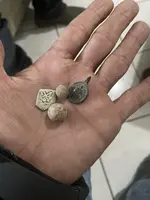Gunner
Sr. Member
- Dec 19, 2004
- 340
- 6
Picked this up a while back. I like fossils too (aside Ancient Coins)!!!  Hope you enjoy it.
Hope you enjoy it.
Gunner
Mosasaur
From Wikipedia, the free encyclopedia
Jump to: navigation, search
Mosasaurs
Fossil range: Cretaceous
An etching of Mosasaur
Conservation status
Extinct (fossil)
Scientific classification
Kingdom: Animalia
Phylum: Chordata
Class: Sauropsida
Order: Squamata
Suborder: Lacertilia
Family: Mosasauridae
Gervais, 1853
Subfamilies
Halisaurinae
Mosasaurinae
Plioplatecarpinae
Tylosaurinae
Mosasaurs (from Latin Mosa meaning the 'Meuse river' in the Netherlands, and Greek sauros meaning 'lizard') were serpentine marine reptiles. The first fossil remains were discovered at the Meuse river about 1780. These ferocious marine predators are considered by some experts to be closely related to snakes, due to extreme similarities in jaw and skull anatomies.[1] Mosasaurs were not dinosaurs but lepidosaurs, reptiles with overlapping scales. These predators evolved from semi-aquatic squamates known as the aigialosaurs, close relatives of modern-day monitor lizards, in the Early Cretaceous Period. During the last 20 million years of the Cretaceous Period (Turonian-Maastrichtian), with the extinction of the last ichthyosaurs and the decline of the Cretaceous plesiosaurs and pliosaurs, mosasaurs became the dominant marine predators.
 Hope you enjoy it.
Hope you enjoy it.Gunner
Mosasaur
From Wikipedia, the free encyclopedia
Jump to: navigation, search
Mosasaurs
Fossil range: Cretaceous
An etching of Mosasaur
Conservation status
Extinct (fossil)
Scientific classification
Kingdom: Animalia
Phylum: Chordata
Class: Sauropsida
Order: Squamata
Suborder: Lacertilia
Family: Mosasauridae
Gervais, 1853
Subfamilies
Halisaurinae
Mosasaurinae
Plioplatecarpinae
Tylosaurinae
Mosasaurs (from Latin Mosa meaning the 'Meuse river' in the Netherlands, and Greek sauros meaning 'lizard') were serpentine marine reptiles. The first fossil remains were discovered at the Meuse river about 1780. These ferocious marine predators are considered by some experts to be closely related to snakes, due to extreme similarities in jaw and skull anatomies.[1] Mosasaurs were not dinosaurs but lepidosaurs, reptiles with overlapping scales. These predators evolved from semi-aquatic squamates known as the aigialosaurs, close relatives of modern-day monitor lizards, in the Early Cretaceous Period. During the last 20 million years of the Cretaceous Period (Turonian-Maastrichtian), with the extinction of the last ichthyosaurs and the decline of the Cretaceous plesiosaurs and pliosaurs, mosasaurs became the dominant marine predators.







 Aceton dissolves resin very slowly and you can see the damage clearly on the surface and also all this long spikes can be bent than in all directions. The resin surface gets soft for sure.
Aceton dissolves resin very slowly and you can see the damage clearly on the surface and also all this long spikes can be bent than in all directions. The resin surface gets soft for sure.



